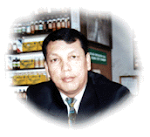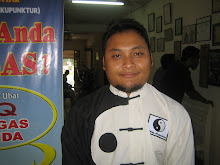Thursday, August 26, 2010
Cerebral Palsy - CP and Acupuncture treatment
What is cerebral palsy?
Cerebral palsy (CP) is an abnormality of motor function (as opposed to mental function) and postural tone that is acquired at an early age, even before birth. Signs and symptoms of cerebral palsy usually show in the first year of life.
This abnormality in the motor system is the result of brain lesions that are non-progressive. The motor system of the body provides the ability to move and control movements. A brain lesion is any abnormality of brain structure or function. "Non-progressive" means that the lesion does not produce ongoing degeneration of the brain. It is also implies that the brain lesion is the result of a one-time brain injury, that will not occur again. Whatever the brain damage that occurred at the time of the injury is the extent of damage for the rest of the child's life.
Cerebral palsy affects approximately one to three out of every thousand children born. However, it is much higher in infants born with very low weight and in premature infants.
Interestingly, new treatment methods that resulted in an increased survival rate of low-birth weight and premature infants actually resulted in an overall increase number of children with cerebral palsy. The new technologies, however, did not change the rate of cerebral palsy in children born full term and with normal weight.
How is cerebral palsy treated?
Most of the causes of cerebral palsy do not have specific, curative treatments. However, children with cerebral palsy present many medical problems that can be treated or prevented. The initial stage of treatment involves an interdisciplinary team, consisting of a pediatrician, preferable one with experience in neurodevelopmental disorders, a neurologist (or other neurological practitioner), a mental health practitioner, an orthopedic surgeon, a physical therapist, a speech therapist, and a occupational therapist. Each member of the team has important, independent contributions to make in the care of the affected child.
* The physical therapist evaluates muscle tone, strength and gait (walking).
* The occupational therapist reviews the child's ability to perform tasks of self-help and care -- from feeding to manual dexterity.
* The speech therapist evaluates the child's ability to speak and understand speech.
Most children with neurological impairment have significant emotional distress and also require therapy from a mental health practitioner.
Virtually all states have federally-mandated programs for the assessment and treatment of children with cerebral palsy and other developmental conditions. In many states, these programs are termed "Regional Centers" and can be found in local phone books. Also Children's Hospitals usually have special clinics with experience with children with cerebral palsy. Furthermore, when a child reaches the age of 3 years, the school district may become formally involved in the review of at-risk children. These programs protect children up to the age of 21 years.
At the present time there is a vacuum in the provision of medical care for adults (young and old) with cerebral palsy living in the community settings. There are a limited number of services in adult hospitals geared to the treatment of adults with cerebral palsy or developmental disabilities.
What Homeopathy & Acupuncture Can Offer
There are as many as 50 Homeopathic remedies recommended by Dr J T Kent, Dr Boericke, Dr Boger for the treatment of CP and there are another 35 acupuncture points can be used for treating CP.
Homeopathic Treatment will take about 8 t0 12 months to see some result.
It is worth of trying rather than wait and see.
Cerebral palsy (CP) is an abnormality of motor function (as opposed to mental function) and postural tone that is acquired at an early age, even before birth. Signs and symptoms of cerebral palsy usually show in the first year of life.
This abnormality in the motor system is the result of brain lesions that are non-progressive. The motor system of the body provides the ability to move and control movements. A brain lesion is any abnormality of brain structure or function. "Non-progressive" means that the lesion does not produce ongoing degeneration of the brain. It is also implies that the brain lesion is the result of a one-time brain injury, that will not occur again. Whatever the brain damage that occurred at the time of the injury is the extent of damage for the rest of the child's life.
Cerebral palsy affects approximately one to three out of every thousand children born. However, it is much higher in infants born with very low weight and in premature infants.
Interestingly, new treatment methods that resulted in an increased survival rate of low-birth weight and premature infants actually resulted in an overall increase number of children with cerebral palsy. The new technologies, however, did not change the rate of cerebral palsy in children born full term and with normal weight.
How is cerebral palsy treated?
Most of the causes of cerebral palsy do not have specific, curative treatments. However, children with cerebral palsy present many medical problems that can be treated or prevented. The initial stage of treatment involves an interdisciplinary team, consisting of a pediatrician, preferable one with experience in neurodevelopmental disorders, a neurologist (or other neurological practitioner), a mental health practitioner, an orthopedic surgeon, a physical therapist, a speech therapist, and a occupational therapist. Each member of the team has important, independent contributions to make in the care of the affected child.
* The physical therapist evaluates muscle tone, strength and gait (walking).
* The occupational therapist reviews the child's ability to perform tasks of self-help and care -- from feeding to manual dexterity.
* The speech therapist evaluates the child's ability to speak and understand speech.
Most children with neurological impairment have significant emotional distress and also require therapy from a mental health practitioner.
Virtually all states have federally-mandated programs for the assessment and treatment of children with cerebral palsy and other developmental conditions. In many states, these programs are termed "Regional Centers" and can be found in local phone books. Also Children's Hospitals usually have special clinics with experience with children with cerebral palsy. Furthermore, when a child reaches the age of 3 years, the school district may become formally involved in the review of at-risk children. These programs protect children up to the age of 21 years.
At the present time there is a vacuum in the provision of medical care for adults (young and old) with cerebral palsy living in the community settings. There are a limited number of services in adult hospitals geared to the treatment of adults with cerebral palsy or developmental disabilities.
What Homeopathy & Acupuncture Can Offer
There are as many as 50 Homeopathic remedies recommended by Dr J T Kent, Dr Boericke, Dr Boger for the treatment of CP and there are another 35 acupuncture points can be used for treating CP.
Homeopathic Treatment will take about 8 t0 12 months to see some result.
It is worth of trying rather than wait and see.
Subscribe to:
Post Comments (Atom)

























No comments:
Post a Comment